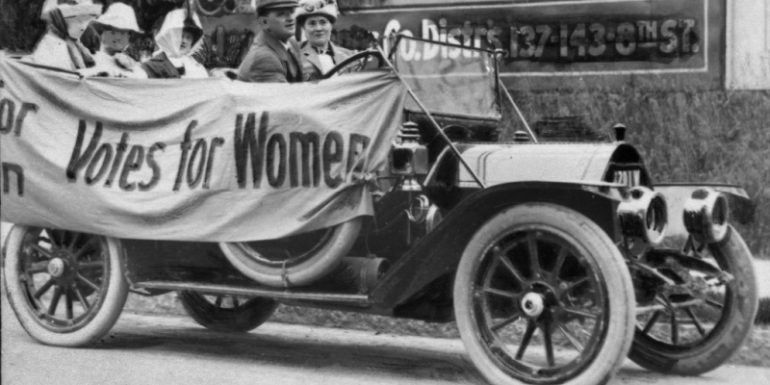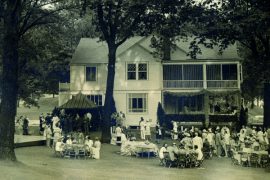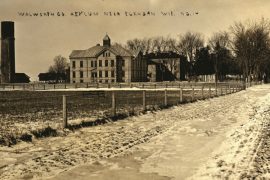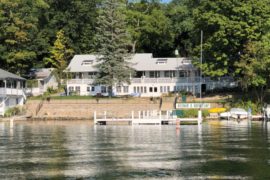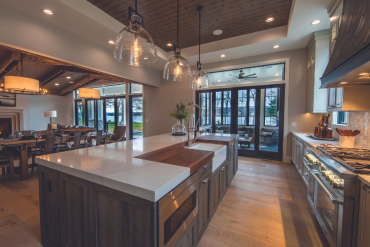By Lisa Schmelz | Photography ©Wisconsin Historical Society
Simone Munson is sitting on her front porch in Black Earth, west of Madison, hoping to have a wide- ranging discussion on Wisconsin’s path to ratifying the 19th Amendment. Inside, her four children, all boys — a 13-year-old and triplet 10-year-olds — are being looked after by their maternal grandmother.
“We might get interrupted,” says the statewide expert on women’s suffrage and the collection development coordinator at the Wisconsin Historical Society, where she’s been for 15 years. “It might get loud. I apologize in advance if that happens.”
No apologies necessary, Ms. Munson. Yes, American women are celebrating the 100th anniversary of federal enfranchisement, but we are still domestically multitasking like the women on whose shoulders we stand.
In putting together an exhibition on the women’s suffrage movement in Wisconsin, Munson had access to a rich trove of primary sources and artifacts. She saw letters that spoke to the movement and the bonds developed between its members. Especially memorable to her are the Clara Bewick Colby papers. Colby, a prominent Wisconsin publisher, journalist and suffrage champion, worked closely with leading suffragists Elizabeth Cady Stanton and Susan B. Anthony and kept some of their correspondence, including a poem Stanton wrote to Anthony.
“The one thing that comes to mind immediately,” says Munson of the movement, “is these women were voracious writers. They were constantly at the typewriter or writing longhand. How did they get anything else done in a day? This poem, it’s a birthday poem, and it speaks to both friendship and the movement.”
To Susan B. Anthony
On her 80th birthday – February 15, 1900
My honored friend, I’ll ne’er forget, That day in June, when first we met.
Ah: would I had the skill to paint, My vision, of that Quaker saint! …
Climbing the rugged suffrage hill, Bravely facing every ill …
All for the emancipation,
Of the women of this nation—Elizabth Cady Stanton
The lines at left are only a brief excerpt, yet they offer a window into the friendships formed between this duo and their half-century fight for the vote — which neither would live to see. Still, their paper trail, and that of other national leaders in the movement, is significant. The paper trail in the state is also significant. Wisconsin, after all, was the first state to ratify the 19th Amendment. But what do we know about local women and the cause? Unfortunately, not as much. However, thanks to the research of three local historians: Marra Andreas of Elkhorn, Chris Brookes of Lake Geneva and Patti Marsicano of Delavan, we’re able to provide a small snapshot of how suffrage history played out in some Walworth county communities.
THE FIRST WOMEN IN LA GRANGE TO VOTE
In the summer of 2014, Marra Andreas was doing something she loved: Researching local history. Specifically, she was trying to determine exactly how folks in Walworth County marked the first celebration of Armistice
Day, a holiday honoring the end of World War I and now known as Veteran’s Day. But something else caught her eye in a November 1920 edition of the Elkhorn Independent.
“One hundred women cast their vote in this place last Tuesday. There were some who did not get out but it was a very good showing for the first time.”
Below those 30 words, marking the first time American women could vote in a national election, were 14 more:
“Jay Agen took a load of hay to Milwaukee Monday morning for Taylor & Earle”
And so it was in La Grange, a tiny enclave just outside what would become the Kettle Moraine State Forest. On Monday, Nov. 1, 1920, Agen transported his hay 50 miles east. The next day, 100 women voters went to the polls for the first time in a national election.
“Basically, these announcements were the Facebook postings of the day,” says Andreas, who was born and raised in Elkhorn, works as a substitute teacher and is a board member for the Walworth County Historical Society, “and this one just grabbed me.”
In an article titled “One Hundred Women,” which Andreas published in the spring 2015 newsletter of the Walworth County Historical Society, she laid out what she was able to find. According to the 14th decennial census, there were 794 people residing in the town of La Grange in 1920. Of those, 473 were over 21 and eligible to vote. And of those 473, 253 were men and 220 were women. That 100 would show up to vote, Andreas says, “is amazing.” But without the actual voter rolls, all she could do was speculate as to who those women may have been.
Did Harriet Kettleson, a single woman of Norwegian descent, who owned and ran her own 80-acre farm vote? What about Margaret and Marie Reddy, a mother-daughter team of Irish descent, who ran Highland Heights Farm on their own? Did Gertrude Kruse, a servant on William Duffin’s 120-acre Way-Side Farm, hold a ballot in her hand? If these women voted, they had a lot to consider. There were 18 races at the county, state and national levels, including the office of U.S. president, which Warren G. Harding won. Also on the ballot was a referendum, relating to how Wisconsin would enforce the 18th amendment and its ban on the manufacture, sale and transportation of intoxicating liquors.
“This [was] a story worth investigating, just so that it can be told and just to kind of satisfy my curiosity as well,” says Andreas. “But I’m not satisfied completely; no, because it would have been really interesting to find the voter rolls for La Grange for the primary in September of 1920 and the presidential election in November of 1920.”
LAKE GENEVA WOMEN WEIGH THE MERITS OF VOTING
Chris Brookes is a retired Lake Geneva Middle School English and social studies teacher and a dedicated local historian. While partnering with the Black Point Estate speaker’s bureau, she worked for months to get the Lake Geneva perspective on the suffrage movement. Among her many research finds was a May 31, 1895 edition of The Herald. The Lake Geneva newspaper devoted a full page in its Women’s Edition section to the question “Do you desire suffrage?” Twenty-eight letters, with one signed by six women, were edited for space and ran.
Like compelling issues today, opinions were mixed. Alice Sherman Barba fell into the undecided camp and was not alone when she said she wanted to see further restrictions on voting, but not necessarily enfranchisement for women.
“I do not personally desire woman’s suffrage, believing that the better policy of our government lies in restricting rather than extending the elective franchise. It seems to me it should be restricted by requiring full citizenship of aliens and by imposing both an educational and property qualification upon all voters.”
Mrs. J. E. Burton, like many of the letter writers, also demurely claimed to not desire it [the right to vote] herself, yet ultimately presented strong evidence for the cause.
“Personally I do not care for it, yet I believe it is a right and just principle. Women are amenable to the same laws that govern men and I believe, if they desire, they should have the same privilege of helping elect good men to make those laws and I think in many respects it would be a benefit if they were allowed the ballot, especially in legislation relating to the temperance question.”
Six sisters in suffrage succinctly offered this:
“We believe taxation without representations is unjust and contrary to the spirit of our government. We believe woman’s right to suffrage is inherent.” Mrs. A.K. Owen, “ M.P. Faulkner, “ E.A. Belcher, “ J.F Furney, “ R. Burt, “ A.F. Bartlett.
Mrs. Ella C. Heg wanted nothing to do with suffrage, thank you very much, and declared:
“Personally I do not desire woman’s suffrage. Why? Home is the place for woman and one politician in the family is enough.”
Brookes’ research also led her to Reinette Lester McCrea. McCrea, she explains, was instrumental in bringing a suffrage automobile tour to Lake Geneva in the summer of 1910, where she summered at her Blacktoft estate. Her wealth and position in Chicago society, and its network of women’s clubs, uniquely suited her to bringing the cause to the shores of Geneva Lake.
“She was a little farm girl from Fulton County, Illinois,” Brookes explains, “and rose to these prominent positions somewhat through marriage but also through her own grit and intelligence.”
McCrea, who also gifted the Three Graces statue to Lake Geneva, with the names of her 10 best friends inscribed on it, helped organize two similar suffrage tours in Illinois, and then brought those speakers here, Brookes adds.
“The paper only said it was a great success,” says Brookes of the event, which apparently was not photographed. “She died in 1916, so she never saw the results of her campaign and her efforts.”
LEADING SUFFRAGISTS SPEAK IN DELAVAN
Patti Marsicano is the president of the Delavan Historical Society and the author of “Delavan” and “Forgotten Delavan,” both published by Arcadia Publishing. While researching the history of an early home on Delavan’s Fifth Street, she happened upon an article that stopped her in her tracks and that was unknown to even the most senior members of the Delavan Historical Society. On Feb. 13, 1878, Susan B. Anthony came to Delavan to deliver a speech titled “Woman Wants Bread, Not the Ballot.”
“I was fascinated,” says Marsicano. “I had never heard that before, never seen that before, so that one little clipping in the newspaper took me down the rabbit hole and I was able to write about new information that had not been shared about Delavan’s history.”
The speech Anthony delivered at Delavan’s Harmony Hall “was deemed a rousing success, enjoyed by both women and men alike,” says Marsicano, and as reported in a story in the Delavan Republican, the city’s newspaper.
Anthony not only spoke in Delavan; she also spent the night. A guest of Mr. William DeMotte, the superintendent for the Wisconsin School for the Deaf, it’s not known if she walked along the brick street downtown, peering into stores like Bradley’s. But it is known that she left petitions to be signed and forwarded to Congress and that the following year, her dear friend and sister in arms, Elizabeth Cady Stanton, came to Delavan in mid-January. Stanton was 62 at the time and the mother of seven children.
Like Anthony, Stanton possessed marketing savvy and titled her speech in a way that she could attract the opposition. “Our Boys” was considered a call for reforms in parenting and education, and also a call for equality for women.
Stanton appears to have spoken twice in Delavan, including a women’s only crowd at the First Baptist Church in the center of the city. From Delavan, Marsicano learned, Stanton headed to Moline, Illinois, for another lecture.
Both Anthony and Stanton came to Delavan under the auspices of the short-lived Delavan Lecture Association. The suffragists, Marsicano says, brought in “good money,” but other speakers were not as popular and poor turnout made them unprofitable for the association.
Though she’s never been able to determine exactly where Harmony Hall was located, Marsicano imagines those in attendance when Anthony and Stanton spoke must have felt a part of something big. “It had to be terribly exciting,” she says. “They were well known women.”
LOCAL TALES ESSENTIAL TO THE ENTIRE STORY
It’s clear that diving into the dusty archives of women’s suffrage isn’t something Munson, the long-time state historical society employee, tires of. Hearing of these local finds only piques her interest more.
“It’s impressive and it doesn’t surprise me,” she says of what Andreas, Marsicano and Brookes unearthed in Walworth County. “There’s often a misconception that the state historical society knows all things, and I can’t tell you the number of times I have referred people to the local level. And the importance of the local tales, like the ones told here by these historians, are so important. When they involve women’s history, they are even harder to tell. But these local historians did it and now those stories have a memory in our community.”
That they do. And we proudly stand on the shoulders of the women before us, who led the charge for women’s suffrage. And we thank the women of today, the women who help us all, in the words of First Lady Abigail Adams, “…remember the ladies.”
SUFFRAGE MOVEMENT ACTIVE IN SOUTHERN WISCONSIN
Another influential suffragist with ties to southern Wisconsin was Olympia Brown. She was the first woman in America to enter the ministry of an organized church, eventually accepting the pastorate of the Good Shepherd Church in Racine. Brown met Susan B. Anthony at a national suffragist convention in 1866 and became a passionate suffragist.
Brown attempted to vote in the 1887 Racine municipal election, arguing that the positions on the ballot pertained to school matters and, therefore, women should be allowed to vote. She was turned away and sued the city. A Racine judge agreed with Brown, however, the decision was reversed by the Wisconsin Supreme Court.

